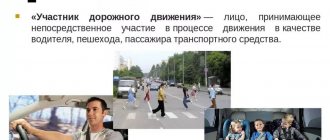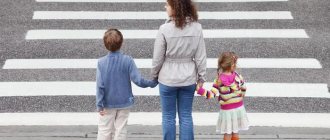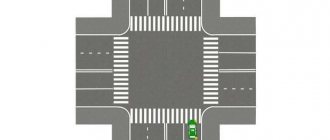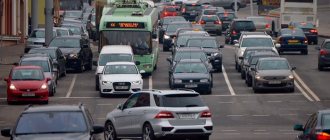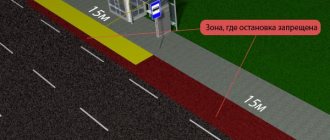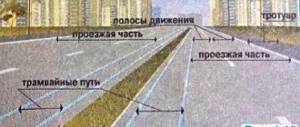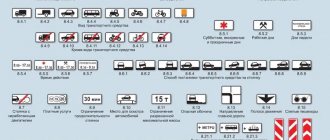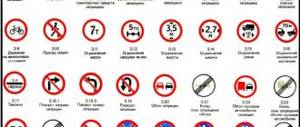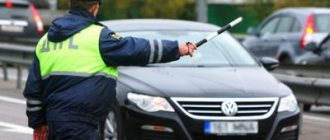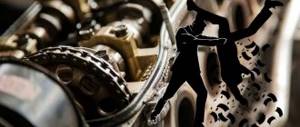Many cyclists think about using their bike as a vehicle and riding it to work, to the country, to shops, to nature... Riding on the sidewalks among pedestrians is quite problematic; there are only one or two special bicycle paths in a city with a population of one million, and even that is not a fact. There is only one option left - roads and highways, and traffic on them is equal to cars.
Not everyone knows that a bicycle is equal to a car, and on the road it is necessary to follow the general rules of movement on the roadway. Going out with a bike unprepared is absurd and dangerous, so now we will determine where and how a bicycle driver should ride and what to follow when doing so.
Bicycle safety in the “iron kingdom”
To ride a bicycle safely on the roadway you must:
- Good condition of transport.
- Required position relative to other vehicles.
- Optimal speed.
- Maintaining distance, lateral interval.
- Attentiveness, good response.
- Visibility from the outside.
- Compliance with the requirements of road signs, markings, traffic lights.
When moving along the roadway, the bicycle must be in good condition. First of all, this concerns the steering wheel and brake system. It is also necessary to check the mounting of the wheels to the frame, the condition of the transmission and the air pressure in the tires.
We decide which side of the road we need to be on. This is a rather controversial issue among cyclists: some argue that it is necessary to ride in the direction of travel, others - “against the grain”, like pedestrians - on the side of the road, others don’t care at all, even if it’s in the middle. So who is right?
Traffic regulations clearly and clearly defined the position of a bicycle on the road: passing other vehicles, moving as far to the right as possible. This could be the edge of the road, the right lane in multi-lane traffic. The key word "possible" means that traffic rules allow cyclists to veer to the left and even enter oncoming traffic. Such cases include:
- Driving around a parked car.
- Poor quality of the road surface, when driving on which you can fall and create an emergency situation.
- Driving through the scene of an accident or cordon.
A group of cyclists moves in one row, in the extreme right position, at a distance from each other. Riding parallel in one lane, as the rules allow for motorcycles, is prohibited for cyclists.
Cyclists are fish in water on the right side of the road
The speed of the bike in traffic is of great importance. According to traffic regulations, driving synchronously with the flow is the safest for each vehicle. On the road it is necessary to develop and maintain a fairly high speed, at least 20 km/h. Driving too slowly interferes with cars, as they are forced to maneuver around the cyclist. This is especially true for narrow roads, where passing oncoming and oncoming traffic is difficult. However, high speed is only safe if all traffic is moving quickly.
Cyclist signals when driving on roads
The distance for a cyclist is the distance between him and other vehicles in length. Side spacing is the distance across the width. For comfortable driving on the road, they must be maintained so that in a dangerous situation you can turn to the side. If the distance behind the car in front decreases, you need to slow down. And, conversely, speed up if it decreases with traffic behind. When moving in parallel, you should not press too close to passing and parked cars, and here’s why:
- There is a risk of falling on the car due to unevenness on the road.
- The door of a parked car may suddenly open.
- A car can hit a cyclist.
Attention is the key to successful cycling as a driver. You should carefully monitor what is happening in front and to the sides. The road is movement, and the situation changes every second. It will be useful to purchase a rear-view mirror and install it on the steering wheel: this way you can keep an eye on the road behind you.
An integral attribute of mindfulness is the reaction: the higher it is, the more opportunities there are to avoid an unpleasant situation. The reaction speed decreases when tired, taking medications and when intoxicated. In these cases, the rules prohibit driving, including a bicycle.
Peace of mind will give the cyclist the confidence to be seen. It is recommended to have reflectors on the frame, lighting devices (a headlight at the front and a flashing red light at the rear) when driving at dusk, and bright clothes, preferably also with reflective stripes.
Became visible - avoided problems and saved life
Traffic rules oblige, along with car drivers, to comply with the requirements of road signs, markings and traffic lights. Current road signs for bicycles:
- Priority signs.
- Crosswalk.
- No entry.
- Prohibiting turns.
- Prescriptive directions.
- Signs of special requirements: one-way traffic, route traffic.
- "Driving in lanes" signs.
Pay attention to the signs
Markings for cyclists:
- Solid line (no crossing allowed).
- Broken line (can be crossed).
- Pedestrian zebra crossing.
- Islands of safety.
- Yellow markings prohibiting stopping and/or parking.
As for traffic lights, everything is simple: red, yellow - stop, green - the road is clear. When the additional section of the traffic light is on, traffic is allowed after other vehicles have passed through the main green section. For a cyclist, the “right” arrow will be relevant.
Types of fines
According to Part 2 of Art. 12.29 of the Code of Administrative Offences, a cyclist is subject to a fine of 800 rubles for violating traffic rules. It is important to consider that this penalty is imposed for a violation during movement. If a cyclist walks and is driven by a vehicle nearby, he is treated as a pedestrian.
This is a general punishment for non-compliance with traffic rules; in some situations, the size of the fine may vary.
Passing through a pedestrian crossing
In this case, the cyclist is equal to the driver. Accordingly, he must be guided by traffic lights or instructions from a traffic controller.
If they are absent, it must provide priority to the pedestrian, allowing him the opportunity to cross the zebra crossing.
Important! A cyclist must cross the road at a pedestrian crossing, getting off the vehicle and driving it alongside (meaning moving across the road, crossing to the other side).
For failure to comply with the rules for driving through a pedestrian crossing, the standard fine is 800 rubles.
Driving on the sidewalk
In accordance with clause 24.2 of the traffic rules, a cyclist can move on the sidewalk legally if:
- he accompanies a cyclist under 14;
- transports a child under 7 years of age (in a designated place);
- there is no bicycle path, and there is no possibility of movement on the side of the road and/or on the right lane of the road.
In most Russian cities there are no special roads for cyclists, so it is quite rare to be held accountable for riding on the sidewalk. But if you meet a particularly principled traffic police officer, punishment for this violation will be imposed. The fine for riding a bicycle on the sidewalk is standard – 800 rubles.
Riding without a helmet
Traffic regulations do not include a bicycle in the list of vehicles that require wearing protective headgear when driving. Therefore, there is no penalty for driving without a helmet. The use of head protection is at the discretion of the cyclist.
Obstructing other road users
If failure to comply with traffic rules by a cyclist provokes interference with the movement of drivers, the punishment is already regulated by Part 1 of Art. 12.30 Code of Administrative Offences. The fine is 1000 rubles.
If the violation of the rules led to harm to other road users, the penalty reaches 1000-1500 rubles (Part 2 of the same article) depending on the specific circumstances of the case.
Drunk driving
There is a separate article for drunk people on bicycles. In accordance with Part 3 of Art. 12.29 of the Administrative Code, driving this type of transport while intoxicated is punishable by a fine. Its size ranges from 1000 to 1500 rubles.
To drive this type of transport you do not need a driver's license. Therefore, drunken riding of a bicycle cannot be grounds for deprivation of a license.
However, if violation of the rules led to an accident with serious harm to the victims, strict sanctions are provided. The cyclist faces criminal penalties under Art. 264 of the Criminal Code of the Russian Federation. In this case, forced labor, arrest or restriction of freedom may be imposed.
Failure to comply with the speed limit
The Ministry of Transport of the Russian Federation is considering the possibility of establishing a maximum speed for bicycles, making them completely equal to motorcycles/vehicles. Along with this, special paths must be created for their movement.
However, the Russian Federation does not yet provide for such restrictions. Therefore, cyclists do not face a fine for speeding. However, for your own safety, it is important to follow the rules established on specific sections of the road.
Important! The minimum limit of 20 km/h can be exceeded both by bicycles equipped with electric motors (they reach up to 25 km/h) and by human power.
Safe flight when maneuvering
Maneuvering on the road is a deviation from a straight trajectory. According to traffic rules, the driver in this situation must give way to vehicles moving straight ahead. Maneuvers on the roadway include starting to move, changing lanes, and turning. We will consider the last category in a separate section, but now let’s talk about how to properly start moving and change lanes.
At the beginning of the movement, you must give way to everyone traveling in the same direction: cars, motorcycles, other bicycles. As soon as a safe gap has formed and other passing vehicles are still far away, we deviate to the left, straighten the steering wheel and pick up speed. When turning onto the road from the adjacent territory (yards, driveways, platforms), it is also necessary to let everyone through.
Changing lanes is necessary when avoiding obstacles or moving in the permitted direction. For example, the right lane is only for right turns, but you need to drive straight. When changing lanes, the trajectory should be as straight as possible, so you need to start deviating to the left in advance. We give way to passing traffic and reduce speed. When driving around obstacles on narrow roads with an exit on the left side, you must stop and let oncoming traffic pass. If the obstacle is on the oncoming side, then the cyclist has the right of way on his territory.
Scheme of passing oncoming traffic on a narrow road
Should I wear a reflective vest and when?
Obliged. Reflective vests or capes have already created a lot of buzz since their introduction on March 18, 2021. But few people thought that cyclists are no exception to the Rules.
The obligation to wear vests is imposed by clause 2.3.4 of the traffic rules, and it applies to drivers of all vehicles, and not just mechanical ones - that is, cars.
In addition, paragraph 24.10 recommends that cyclists, when riding in the dark, in rain or fog, install or wear something with reflective elements.
Thus, cyclists are required, in the event of a forced stop or in an accident, while on the roadway or on the side of the road at night outside a populated area, to wear reflective clothing in accordance with GOST.
If you don't have a vest with you
As you can see, the loophole is simple: just leave the road and stand to the side. Please note that you also need to get off the side of the road.
Driving through intersections and crossing roads
In general, there are four ways to drive through a road intersection: continue straight, turn right or left, or turn around. A right turn for a cyclist is allowed at all regular intersections, as it is made from the extreme right position - the legal place of the cyclist.
A cyclist can also freely ride straight from his lane, and he will have an advantage over those turning right. If the right lane is only for a turn, then to drive straight you need to change lanes into the adjacent lane, having first given way to everyone who does not intend to change lanes.
A bicycle driver is only allowed to turn left and change direction from roads where there is one lane in each direction and there are no tram tracks. By the way, about trams: at intersections they have an advantage over a bicycle; if the red light is not on for it, it does not leave the secondary road or the depot.
The tram is always the main one
Warning instructions for turning: “right” - an outstretched arm to the right, “left” and “turn” - an outstretched arm to the left. The direction of turn must be shown in advance, before the maneuver.
Giving signals when turning - good manners, serious approach
Crossroads are divided into several types:
- Unregulated, equivalent roads.
- Without traffic lights, with a certain priority.
- Adjustable.
The first type of intersections is passed according to the “interference on the right” rule. We look to the right and miss everything that moves from there. When turning left at such intersections, you must give way to the entire oncoming traffic unless it has its own obstacle on the right (to the left of the bicycle).
Driving directions “obstruction on the right”
Intersections with priority are intersections of roads where, according to the rules, some pass “without looking”, others give way. The former move along the main road, the latter are on the secondary road. On the main road, a bicycle has the right of way, just like a car. However, you need to be careful, slow down a little and pass only if they really allow you to do so.
The most unpleasant maneuver on the main road is turning left. Here you will need to first let through all the passing people, and then the oncoming ones. Sometimes the main road may change direction: there is an information board under the sign. If such a road turns left, then there is no need to let anyone through. On a secondary road, a bicycle is inferior to everyone driving on the main road if they intend to drive straight or to the left, and only to future passing vehicles when turning right.
Intersection with priority passage
Signalized intersections are usually intersections of major streets where left turns will not be permitted. There are two ways to rotate:
- Get off your bike and cross the zebra crossings.
- Drive "at the corner": straight on the green, turn 90 degrees and drive straight on the green again. This can be done where there are no pedestrian crossings, and if there are no cars parked at the edge of the road. In general, the first option is safer.
Turn left from a multi-lane road at the corner (green lines)
You are allowed to drive straight and to the right when the signal is green, including a flashing one. You can complete the intersection on yellow or even red. If the traffic light is flashing yellow or turned off, then we look at the priority signs or get off and cross the road on foot.
There are also T-shaped signalized intersections. They are interesting because you can turn left from a road without a direct passage, even if there are more than one lane. To do this, you need to move to the left lane in advance and calmly turn on green: the bicycle will be to the right of everyone and will not create interference. Don't forget to give turn signals when changing lanes and before turning.
Attention! When turning right or left, you can cross a pedestrian crossing only if there are no people on it. That is, we act like in a car: at turns we let all pedestrians pass, and we also let them complete the transition.
You need to cross the road with a bicycle with your own feet, using a pedestrian crossing. Unfortunately, many people neglect this and ride directly on the saddle. This cannot be done for the following reasons:
- You can hit a pedestrian at a zebra crossing.
- There is a danger of crashing into a curb and falling off your bike.
- A car driver turning a corner may not notice a cyclist and hit him.
The same applies to controlled crossings (without an intersection): the rules clearly state that a cyclist is required to cross the roadway as a pedestrian. A self-respecting bicycle driver always remembers where he can and cannot ride.
This is the wrong cyclist
I think each of us can confidently say that in Russia we drive on the right hand side. And to the question “ Which side of the road should a bicycle (car/bus/motorcycle) ride on?”
everyone will answer: “On the right side of the road.”
Moreover, schools now teach the basics of traffic rules for pedestrians and cyclists. And a cyclist who decides to enter the roadway is simply obliged to study the traffic rules that concern him before doing so. Fortunately, there are few of them.
And yet, every summer I encounter careless cyclists who ride along the edge of the right lane of the road in the opposite direction. Moreover, I usually encounter such irresponsible citizens, being on horseback myself.
What do they write in the traffic rules?
According to traffic regulations, in the absence of sidewalks and curbs, a pedestrian can move along the road in the opposite direction. But if you are riding a bicycle, then you are a vehicle and are obliged to move only in the same direction!
Remember: you can only ride a bicycle on the roadway in the same direction and if there is no bicycle path nearby!
If you're scared to drive on public roads and shy away from every car passing by, maybe it's just not worth it? The feeling of being in control of the situation when driving in oncoming traffic is false: if something happens, the reaction to prevent an accident will most likely not be enough, and looking at a truck approaching at full speed seems like a terrible thing to me. If you are afraid to regularly look behind you on the road, buy a bicycle mirror; Rear and front markers and bright reflective clothing are also mandatory on the road.
It is worth paying attention to the persons driving the bicycle. According to traffic rules, they must drive the bike in the same direction. Although, I would leave this question open.
Why can't a cyclist ride in oncoming traffic?
- Speed difference
Let's say that in city mode the average cyclist travels at a maximum speed of 30 km/h, and the average car travels at 60 km/h. In oncoming traffic, their relative speed is 90 km/h, and in passing traffic – 30 km/h. The difference in relative speed is 3 times!Accordingly, there are also risks for the cyclist.
- The suddenness of a cyclist's maneuvers
Imagine you are flying downhill on a bicycle along the right (and for you, the left) edge of oncoming traffic. And at high speed, suddenly a stone/oil/puddle gets under your wheel, as a result of which you can fall or suddenly turn sideways. Result: you fly at full speed into an oncoming car rushing towards you. In the case of passing traffic, the chance that the driver will have time to dodge is much higher. - Obstacle for other drivers:
cyclists, drivers of mopeds and other low-speed vehicles. By moving against the grain, you interfere with other cyclists, slow-moving vehicles and cause negative attitude towards cycling enthusiastsfrom motorists. There are often situations when I am riding along the edge of the right lane in the same direction, there is a continuous stream of traffic on the left, a bump stop on the right, and a satisfied cyclist, sincerely confident that he is right, is riding against the grain. Honestly, I want to hit you in the forehead. To each.
I hope that at least one cyclist, after reading this article, will stop practicing English driving on the left in Russian realities. Do not violate traffic rules, respect yourself and other road users, regardless of the vehicle they choose!
PS
Be sure to test your knowledge of traffic rules by clicking on the picture next to it!
According to clause 1.2 of the current traffic rules, a cyclist is a person driving a bicycle. A bicycle, in turn, is considered to be “a vehicle, other than a wheelchair, that has at least two wheels and is generally propelled by the muscular energy of the persons on the vehicle, in particular by means of pedals or handles, and can also have an electric motor with a rated maximum power in continuous load mode not exceeding 0.25 kW, automatically switching off at a speed of more than 25 km/h.”
It is worth noting separately that according to the rules, pedestrians are considered to be persons “who use roller skates, scooters and other similar means for movement” - that is, a bicycle is considered to be a vehicle with a wheel drive (or wheels). In addition, if a person does not ride a bicycle, but carries it next to him, then he is also considered a pedestrian, not a cyclist.
Another note regarding the classification of a bicycle as a vehicle: the bicycle itself is a vehicle, but is not a motor vehicle, since the latter is understood as a “vehicle driven by an engine.” This is important in terms of the rules and penalties that apply to cyclists.
The answer to the key question that worries many is yes. The traffic rules have a separate section 24 containing “Additional requirements for the movement of cyclists and moped drivers.” Paragraph 24.2 of this section allows the movement of cyclists on the right edge of the roadway. This, however, is permitted if “there are no bicycle paths, bicycle pedestrian paths, or a lane for cyclists, or there is no possibility of moving along them.”
Moreover, when driving on a road, a cyclist uses standard priority rules, and a car moving on a secondary road must yield to a cyclist moving on the main road. And paragraph 24.5 allows “the movement of a column of cyclists in two rows if the overall width of the bicycles does not exceed 0.75 m.” The only condition for this is that “the column of cyclists must be divided into groups of 10 cyclists in the case of single-lane traffic or into groups of 10 pairs in the case of double-lane traffic”, and “to facilitate overtaking, the distance between groups should be 80 - 100 m” .
Under normal conditions, according to clause 24.1, “the movement of cyclists over the age of 14 years must be carried out on bicycle paths, bicycle pedestrian paths or a lane for cyclists.” And one more thing: cyclists under 14 years of age are prohibited from riding on the roadway or on the side of the road.
The list of additional prohibitions for bicycle drivers is regulated by clause 24.8 of the current traffic rules, and besides it, the traffic rules contain other points that mention restrictions on the movement of cyclists. Here we will highlight the main prohibitions regarding their movement on roads.
To begin with, cyclists are concerned with clause 2.7, which stipulates a ban on driving a vehicle while under the influence of alcohol or drugs , as well as talking on a mobile phone without using hands-free devices. The only nuance here is that the fines provided for violating the rules by cyclists are significantly lower than those for motorists - this will be discussed below.
Clause 16.1 prohibits the movement of cyclists on highways, as well as on roads marked with sign 5.3 - “Road for cars”.
Well, the notorious clause 24.8 prohibits cyclists from “turning left or turning around on roads with tram traffic and on roads that have more than one lane for traffic in a given direction,” as well as “crossing the road at pedestrian crossings.” Thus, in order to turn left, a cyclist will either have to do it “in two steps”, crossing the road to which he needs to turn, and then, stopping, enter it at the next traffic light, or dismount and cross the current road at a pedestrian crossing.
In addition, it is worth remembering that cyclists also have their own prohibitory sign 3.9 “Movement on bicycles is prohibited”, which is supplemented by the standard “brick” (3.1) and “Movement is prohibited” (3.2).
Violations by cyclists of the rules and prohibitions indicated above, as well as other rules not related to traffic on roads and not listed here, are regulated by parts 2 and 3 of Article 12.29 of the Code of Administrative Offenses of the Russian Federation. According to Part 2, violation of traffic rules by a cyclist “entails the imposition of an administrative fine in the amount of eight hundred rubles.” If the bicycle driver was drunk at the time of the violation, then a fine will be imposed on him “in the amount of one thousand to one thousand five hundred rubles.”
As you can see, the punishment for drunken driving here is much less severe than in the case of motorists , but it, however, became significantly tougher in 2013: before that, for a violation one could get off with “a warning or the imposition of an administrative fine in the amount of two hundred rubles,” and a drunk the cyclist was punished with a fine of “three hundred to five hundred rubles.”
According to the facts
And it's sad. Anyone who has acquired a two-wheeled friend and learned to pedal can ride a bicycle. To drive a bicycle, you do not need to pass a traffic police exam. Hence the widespread illiteracy of cyclists.
Therefore, it would be nice to understand how and where you can ride a bicycle in accordance with the traffic rules.
General provisions of traffic rules
Let's understand the fundamental concepts.
Bicycle according to clause 1.2 of the Russian Traffic Regulations:
Vehicle is a device designed to transport people, goods or equipment installed on it on roads.
A road is a strip of land or a surface of an artificial structure that is equipped or adapted and used for the movement of vehicles. The road includes one or more carriageways, as well as tram tracks, sidewalks, shoulders and dividing strips, if any.
A pedestrian is a person who is outside a vehicle on the road and is not working on it. Persons moving in wheelchairs without a motor and driving a bicycle
, moped, motorcycle, carrying a sled, cart, baby or wheelchair.
The carriageway is a road element intended for the movement of trackless vehicles.
.
A sidewalk is a road element intended for pedestrian
and adjacent to the roadway, or separated from it by a lawn.
It is very important to remember that a bicycle is a means of transport. This means that all traffic regulations concerning vehicles also apply to cyclists.
Mandatory requirements for a cyclist
There are no special requirements for a bicycle driver. Like motorcyclists, you don’t need to wear a helmet. But for personal safety, it’s still worth getting one.
Before leaving, a cyclist, like the driver of any vehicle, is obliged to check and ensure that the vehicle is in good technical condition
vehicle.
What warning lights should be on a bicycle?
In the dark, the headlights or lanterns must be turned on on the bicycle, and in the daytime, low beam headlights or daytime running lights:
Do you turn on the front headlight on your bike during the day? I honestly don't. Although I thought about it. After all, the traffic rules say “vehicle,” and a bicycle, as we figured out at the very beginning, is also a vehicle. But a traffic police officer can slap a fine on you.
Attention! It is prohibited to drive when the headlights and tail lights are not on (or missing) in the dark or in conditions of poor visibility.
Where can you ride a bike?
- Along bicycle paths, bicycle pedestrian paths, or lanes for cyclists.
- On the right edge of the roadway.
- On the side of the road.
- On the sidewalk or pedestrian path.
Moreover, the points are mutually exclusive. Those. if there is a bicycle path and you ride on the right edge of the roadway, then this is a traffic violation. Please note that driving on the sidewalk is only permitted as a last resort. But in everyday life the opposite often happens.
Bicycles should only travel in one row, as far to the right as possible. Driving on the side of the road is allowed if this does not interfere with pedestrians.
Do cyclists need to show turn signals?
Yes.
Here's what the traffic rules say about this:
How to show turn signals with your hand
I've seen some cyclists install turn signal lights with a switch on the handlebars. Usually indicators are attached under the saddle. But I wouldn’t be lazy about showing turns with my hand—what percentage of motorists expect to see a cyclist holding a turn signal under the saddle?
How and when should you not ride a bicycle?
Riding a bicycle includes all prohibitions on driving a car (being drunk, violating the rest schedule, talking on the phone, etc.) + you cannot:
- drive without holding the steering wheel with at least one hand;
- transport passengers, except a child under 7 years of age, on an additional seat equipped with reliable footrests;
- transport cargo that protrudes beyond the dimensions by more than 0.5 m in length or width, or cargo that interferes with control;
- move along the road if there is a bicycle path nearby;
- turn left or turn around
on roads with tram traffic and on roads with more than one lane for traffic in a given direction. - The towing of bicycles and bicycles is prohibited, except towing a trailer designed for use with a bicycle.
- Cyclists are prohibited from riding on highways.
I would like to emphasize once again that driving is prohibited if there is a malfunction of the service brake system, steering system, headlights are not lit (missing) and tail lights in the dark or in conditions of insufficient visibility.
A very important point is the prohibition of turning left on roads where there are more than two lanes for traffic in one direction. If you still need to turn left, then this is done like this: the cyclist reaches the intersection, gets off the bicycle (at this moment he becomes a pedestrian with a bicycle) and carries the bicycle along the pedestrian crossing in the right direction.
Should a cyclist give way to pedestrians?
- The driver of a vehicle is obliged to give way to pedestrians
crossing the roadway at an unregulated pedestrian crossing. - At controlled pedestrian crossings, when the traffic light turns on, the driver must allow pedestrians to complete crossing the roadway in that direction.
Fines for cyclists
In theory, if a bicycle is the same vehicle as a car, then the fines should be the same. But Article 12 of the Code of Administrative Violations of the Russian Federation excludes a bicycle from the category of vehicles:
But the Code of Administrative Offenses has a special article for cyclists, which provides for fines for violating the rules:
Almost any traffic violation will result in a cyclist being fined 800 rubles . And for a violation committed while intoxicated - 1,000 - 1,500 rubles. For comparison, driving a car while intoxicated is punishable by 30,000 rubles.
In conclusion, I suggest watching the interview “Traffic Rules for Cyclists” with a traffic police officer. In this interview, a traffic police officer explains many points, as well as how it is correct for a cyclist to turn left if there are more than two lanes on the road for traffic in a given direction.
VeloGrodno » Infrastructure » How to ride correctly for a cyclist to avoid getting a fine
The bicycle boom in the Belarusian capital began several years ago. Of course, Minsk is not Copenhagen, but all cyclists in the world have one thing in common: the requirement to comply with the traffic rules of their countries.
The Komsomol member of Belarus has compiled the rules for cyclists into infographics.
1. Can a cyclist ride on the road?
If there is no bike lane, the cyclist must ride on the sidewalk or pedestrian path without obstructing pedestrians.
If there are no bike paths, sidewalks or pedestrian zones nearby, you need to ride along the side of the road or along the edge of the roadway. BUT! Firstly, you can drive no further than one meter from the right edge of the roadway. You can drive further than one meter only to avoid obstacles and in permitted cases of turning left or making a U-turn. Secondly, if there is an asphalt shoulder on the road, separated from the main roadway by a solid white or yellow line, you need to drive without driving onto the line.
2. At what age can you ride a bicycle on the roads?
In pedestrian and residential areas, on sidewalks, on bicycle or pedestrian paths, you can ride at any age. But you can only travel on the road unaccompanied by an adult from the age of 14.
3. How to drive through intersections?
Riding a bicycle through a pedestrian crossing is prohibited. The cyclist must stop, get off the bike and roll it in his hands along the zebra crossing. Exception: “green bicycle crossings” - places marked with special green markings. These are already being made in Minsk.
But we must take into account that according to the rules, intersections are not places where a bicycle path crosses a road. You don’t have to get off your bike here, but you need to give way to all traffic that crosses the bike path.
4. What should be on the bike
In the dark, as well as in conditions of poor visibility, for example in fog, according to the rules on a bicycle, a light with a white light should be on in front, and a red one on the back. The use of other light elements (reflective vests, reflectors, flickers, etc.) is not regulated by traffic regulations, but experienced cyclists are advised to have them. It's the same with helmets.
STAY IN TOUCH!
What a cyclist should not do
— Turn left or make a U-turn on roads that have more than one lane in each direction.
— Turn left or turn around on roads where there are trams.
— Transport passengers on a frame or trunk without a special seat.
- Drive in snow or ice.
— Carry cargo that protrudes more than half a meter beyond the dimensions, and cargo that interferes with the control of the bicycle.
— Pulling another bicycle on a rope (except for an industrial bicycle trailer).
— Ride faulty bicycles.
— Ride a bicycle “without arms” or “without legs”
ADVICE "KP"
“When moving on the sidewalk, stay close to the roadway”
Chairman of the Board of the Minsk Bicycle Society Evgeniy Khoruzhy shared his advice with Komsomolskaya Pravda readers.
1. If we are driving along the road and need to make a maneuver or go around an obstacle (for example, a parked car), we do this. First, we show with our hand that we are turning, hold our hand for a few seconds, look back and only then turn, making sure that the path is clear. When driving around parked cars, be careful - their doors may suddenly open.
2. The bell will help warn pedestrians of your arrival. If you do this in advance, it will be much easier to drive on the sidewalk - try it!
3. When crossing exits from yards, do not forget that visibility in these places is often limited, and some car drivers may be inattentive. Therefore, control the situation and slow down if you think that the driver may not notice you or simply not let you through.
4. When moving along the sidewalk, stay on the side closest to the roadway. This will make it safer for both you and pedestrians. This is a general rule for installing bike lanes because pedestrians often enter buildings along the street and cross the road in much fewer places.
5. If you are driving around an obstacle that blocks visibility, slow down and stay as far away from it as possible so as not to hit a pedestrian or cyclist coming around the corner. Also, don’t go around pedestrians too closely, so you won’t scare them and won’t collide if someone suddenly steps to the side.
AT THIS TIME Drunk bicycling will result in a $75 fine.
A cyclist is a full-fledged participant in road traffic. Therefore, responsibility for violations is the same as for car drivers.
For violating traffic rules, a cyclist can be punished with a fine of up to 450 thousand rubles. If the violating cyclist is drunk or high, or he refuses to be examined, the fine will range from 450 to 750 thousand rubles. But they cannot take the car away from a drunk cyclist, even if they catch him in this state several times: cyclists are not subject to the confiscation law.
If a cyclist’s violation (even if “sober”) resulted in the creation of an emergency situation, the fine is from 450 thousand to 1.2 million.
Well, if as a result of an accident property is damaged or the victim receives minor bodily injury, the fine can reach 3 million rubles. A cyclist who leaves the scene of an accident faces the same punishment.
WHAT ABOUT THEM?
In Europe you are punished for walking in a bike path
In all European countries, a bicycle has every right to be on the roadway,” Yevgeny Khoruzhy, chairman of the board of the Minsk Cycling Society, told Komsomolskaya Pravda. - Moreover, in many countries, riding a bicycle on the sidewalk is prohibited, and you can be fined a considerable amount for this. Belarus is the only country known to me where cyclists are actually equated with pedestrians, which leads to a large number of conflicts and controversial situations.
Some countries allow driving on sidewalks, while others allow left turns on a multi-lane road (this is a rather dangerous maneuver that requires appropriate infrastructure and driving culture for road users). Cyclists are often allowed to overtake stationary or slow-moving vehicles on the right side, using caution.
Pedestrians can enter the bike path only as a last resort - if it is not possible to walk on the sidewalk, if it is impossible to move on the sidewalk, being careful and not interfering with cyclists. In our country, unfortunately, pedestrians are not punished for being on the bike path.
BY THE WAY
According to Belarusian rules, electric bicycles are equal to mopeds, which means that an AM category license is needed. But the traffic regulations of European countries classify such vehicles as ordinary bicycles, however, subject to certain conditions.
In addition, the rules of most European countries provide signs that can be used to allow oncoming traffic of cyclists on one-way roads (a popular solution for the central streets of many cities).
Source Komsomolskaya Pravda in Belarus
Which side of the road should cyclists ride on?
Many cyclists use a bike as a practical vehicle and ride it to the shops, to the country, to nature and even to work.
The only problem is the lack of the required number of special bike paths; for example, for a city with a population of one million there may be only one or two. There is only one option left - moving along with cars on roads and highways.
To travel safely, every cyclist must strictly adhere to the traffic rules, which, among other things, state in black and white which side of the road the cyclist should ride on..
Riding an unprepared bicycle is ridiculous and extremely dangerous, so it is important to determine how and where a cyclist should ride and what to follow when doing so.
Cyclist safety
Not everyone understands that a bicycle is equal to a car, so on the road a cyclist will need to follow the general rules of movement on the roadway (regarding non-motorized vehicles).
Let's look at what important factors need to be taken into account for the safe movement of cyclists.
Serviceability
First of all, the cyclist is obliged to carefully monitor the serviceability of the vehicle.
Namely, check all the most important parts of the bicycle (handlebars, working brakes), check whether it is equipped with other important parts for driving on the highway:
- reflectors (back, front, and sides);
- flashlights that work at night;
- a working bell to sound a signal.
A cyclist must highlight his bicycle on the roadway so that both the vehicle and the driver himself are clearly visible to all other road users.
Road signs
Bicycle drivers should be especially attentive to the following signs:
- priority signs;
- signs of special instructions (informing about the movement of route vehicles, one-way traffic);
- signs that indicate the direction of movement;
- signs prohibiting turns and entry.
However, the cyclist must also know all other signs and strictly observe them. While driving, the bicycle driver should also take into account road markings:
- It is forbidden to cross a solid line;
- do not stand in places that are marked in yellow;
- allow pedestrians to cross the zebra crossing.
Also, the cyclist must move correctly in a group, be extremely attentive and have good reactions.
Speed
According to traffic regulations, moving synchronously with the flow of cars is the safest option for each vehicle.
But on the road you should develop and maintain a fairly high speed, at least 20 km/h.
Sticking to this speed limit is necessary because driving too slowly can interfere with cars, as they will have to maneuver around the cyclist.
This is especially true on narrower roads, where passing oncoming and passing traffic is difficult.
It is worth noting that high speed is only justified if all other vehicles are moving quickly.
Distance
For a cyclist, distance is the distance in length between other vehicles and him.
Side spacing is the distance across the width. Safe and comfortable riding on the road requires maintaining a distance and interval so that if a dangerous situation develops, the cyclist can turn to the side.
If the distance with the car in front decreases, you will need to slow down, or vice versa - speed up if the distance decreases with the vehicle behind.
In case of parallel movement, you should not press too close to parked or passing cars, and there are good reasons for this:
- There is a chance of falling on the car as a result of an uneven road.
- The car may hit the cyclist in some way.
- The door of a stationary car may suddenly open.
So, attentiveness is the key to safe cycling. In this case, you should carefully monitor what is happening on the sides and in front.
The road is movement, so the situation can change every second. It is useful to purchase a special rear-view mirror and attach it to the steering wheel, thanks to which you can also monitor the road from behind.
Where to go?
Which side should cyclists ride on? This is a rather controversial issue among bicycle drivers: some argue that you need to move in the direction of travel, some prefer to ride “against the grain,” and others do not think about this issue at all. Who is right?
The traffic rules also determined that riding cyclists over 14 years of age is possible in descending order:
- Along bicycle pedestrian or bicycle paths or a lane for cyclists.
- On the roadway along its right edge.
- On the side of the road.
- Along a pedestrian path or sidewalk.
It is worth noting that all subsequent items in the above list apply if the previous ones are missing. For example, you can move along the side of the road only if there is no bicycle lane or path, as well as if there is no possibility of driving on the roadway (along the right edge).
Additionally, there are a few exceptions:
- It is allowed to ride on the roadway if the width of the load or bicycle exceeds 1 meter.
- It is also allowed to move on the roadway if the movement is carried out in columns.
In some cases, in the event of a breakdown or injury, the cyclist has to walk along the roads with the bicycle. Wondering which side of the street you'll be on while riding a broken bike?
In this case, it should be remembered that when moving on the roadway outside populated areas, pedestrians are required to follow the movement of other vehicles. However, persons driving a bicycle must walk in the direction of other vehicles.
When choosing a route, a bicycle driver should give preference to roads with low traffic and less intense traffic, which will make riding easier, safer, and help avoid unwanted accidents.
Features of the movement of young cyclists
- The movement of cyclists aged 7 to 14 years is permitted on sidewalks, bicycle, bicycle and pedestrian paths and within the boundaries of pedestrian zones. It is prohibited to drive on the roadway, shoulder and bicycle lanes.
- The movement of cyclists under 7 years of age is permitted only together with pedestrians (on pedestrian paths, bicycle and pedestrian paths, sidewalks and pedestrian zones).
While driving on pedestrian paths, sidewalks, pedestrian zones and roadsides, the cyclist is obliged not to interfere with the movement of other persons. If necessary, the cyclist must dismount from the bicycle and continue moving as a pedestrian.
Special signs for cyclists
To indicate the maneuver, the Traffic Rules provide the following signs:
- Changing lanes or turning to the right: right arm extended or left arm extended, bent at the elbow.
- Changing lanes or turning left: left arm extended or right arm extended, bent at the elbow.
- Stop: any hand raised up.
- Pits on the right: right hand down.
- Pits on the left: left hand down.
It is not recommended to use alternative methods (where the arm is bent), since the driver may not understand.
When moving in a column, the leader gives the signs first, and all members of the group immediately repeat them. Below we consider actions that cyclists are prohibited from doing.
Unacceptable actions
Cyclists are prohibited from:
- Ride on roads in a populated area if there is a bicycle path. It is indicated by a round sign with a white bicycle on a blue background.
- Turn left or turn around on a road with tram traffic.
- Bicycles are prohibited on highways.
- Towing bicycles is prohibited (do not use hitches, cables or other tricks or devices).
Common rule violations
The most common violations by bicycle drivers include riding toward oncoming traffic or riding in a crosswalk.
In the above situations, cyclists often simply forget that they have already become drivers, but at heart they continue to remain pedestrians.
Both of these maneuvers are extremely dangerous, but this especially applies to the movement of a cyclist along a pedestrian crossing.
Unfortunately, the most common victims of such violations are children, and the driver of the car is not to blame, since he must only let pedestrians pass, and cyclists do not belong to this category.
So, strict and timely compliance with the rules of cycling on the road surface will certainly contribute to safety and comfort. To everything else, we can add that patience and respect on the road are another key to successful travel.
Where it is advisable to travel, not worth it, prohibited
When choosing a route, it is recommended to choose roads with low traffic: this way the ride will be more comfortable, faster, and there will be less risk of getting into an accident or being poisoned by exhaust fumes.
You can, but you should not drive on streets that are too wide and have heavy traffic. Of course, an experienced road cyclist will ride everywhere, but if there are more reasonable options, it is better to choose them. Also, do not overuse driving on highways and roads with a large number of heavy vehicles. We must remember that a truck and a bicycle are incomparable things.
It is prohibited to ride a bicycle on highways without traffic lights. The speed of cars on such roads is usually close to 90 km/h even in the right lane, and a modest 25-30 km/h is completely out of place here. It is also prohibited to ride on two wheels in tunnels.
If the rules are strictly and timely followed, cycling on the roads will be relatively safe and comfortable. To these should be added the unspoken principle of the “three Ds”, as well as being respectful and patient with other participants. There can never be too much politeness, but it will definitely return.
What is prohibited for cyclists under traffic rules?
So, in addition to prohibited sections of the road for driving under certain conditions, in general cases cyclists are also prohibited from:
- drive with faulty brakes, steering wheel and horn,
- drive a bicycle next to the direction of traffic (unlike pedestrians, cyclists in this case must walk in the direction of travel - section of the traffic rules),
- move along the highway (clause 16.1 of the Rules),
- drive without hands (you must hold onto the steering wheel with at least one hand - clause 24.8),
- transport objects that protrude more than half a meter along the length of the bicycle,
- transport people, unless it is a tandem bicycle,
- turn left or turn around if this section of the road has more than 1 lane in your passing direction or tram tracks,
- ride a bicycle on a pedestrian crossing,
- tow another bicycle or any other vehicles (clause 24.9),
- drive under road sign 3.9:
Who will be at fault in an accident?
No matter how trivial and obvious it may sound, the one who violated the traffic rules will be to blame for the accident. In some situations, car drivers violate, in others, cyclists do. Let’s look at some of them.
At a pedestrian crossing
It’s not for nothing that we focused on the ban on the movement of bicycles on the checkpoint. Very often, violation of this prohibition causes accidents. If the driver himself did not violate anything, for example, did not run a red traffic light, then the cyclist himself will be guilty of an accident at a pedestrian crossing with a cyclist who did not dismount.
Judicial practice in 2021 is quite rich. Here, for example, is the court's decision in a case where a driver hit a cyclist riding along a crossing, but he himself was moving at a speed limit. He was eventually found guilty.
In this category of cases, it’s easy to get a “reciprocity”, because we have a miraculous clause 10.1 in the traffic rules, according to which the driver is obliged to foresee and foresee everything (according to inspectors and judges). In a similar case, the first instance found the cyclist guilty, and the appeal established the guilt of everyone at 50%, here is the appeal determination.
And finally, the appellate ruling, which upheld the decision of the first instance in an accident between a cyclist who did not dismount at a pedestrian crossing and a car. Now the cyclist has to pay for the damage caused to the car. But even in such accidents involving a collision with a bicycle, not everything is so simple; sometimes the driver, even in the absence of guilt, must pay for the damage to the bicycle driver - we will discuss this in more detail below.
When turning right
Cyclists on the road do not always behave well and strictly follow the assigned rules, but if they move along the right edge of the roadway, then, as a rule, they do so in an extreme position.
The same cannot be said about car drivers who, when turning right, often forget to follow paragraph 8.5 of the traffic rules and take the extreme position before turning right, as a result of which they knock down cyclists. In this case, the driver’s fault will be clear. The extreme position is extreme so that no one else can pass (fit) there.
Drivers can also turn right, violating another clause of the rules, namely 13.1, which states that you need to give way to cyclists who are crossing the roadway on which the turn is being made.
Judicial practice : appeal ruling of the Sverdlovsk Regional Court, which recognized as legal the decision to collect 200,000 rubles in compensation for moral damage from the driver. The driver violated clause 13.1 of the Russian Traffic Regulations.
The maneuver of leaving the road into the adjacent territory requires increased attention from drivers, since you can easily get into an accident with the participation of a cyclist and find yourself at fault. After all, clause 8.3 of the Rules prescribes giving way to two-wheelers whose path is crossed by a car.
Important note!
- This article describes the basic principles of how legislation works. Meanwhile, in judicial practice everything depends on specific circumstances.
- In 96% of all cases there are subtleties that can affect the outcome of the entire case.
- Therefore, we recommend entrusting the matter to professionals who will study your business and select the right winning strategy.
The TonkostiDTP website employs professional road accident lawyers with experience in all major types of disputes (MTPL, guilt, administrative penalties).
Ask a lawyer
or get a free consultation by calling the hotline: 8.
What if the cyclist is drunk?
In this section, we will dispel the popular myth, which concerns not only cyclists, that if you drive a vehicle while drunk, then you are a priori guilty of an accident. This is wrong!
If a drunk man steers a bicycle strictly according to the rules, then no one will find him guilty of an accident, because he simply will not be to blame for it, since the state of intoxication is not in a cause-and-effect relationship with the road accident itself. This is exactly how the courts are reasoning in 2021.
If someone driving on the right is hit
The small dimensions of the bicycle allow you to ride it close to the edge of the roadway, but this is also a danger for people. Car drivers are accustomed to the fact that there is no one on their right, since a car cannot pass there, but a bicycle (and, indeed, a motorcycle) can easily do so.
The appearance of a two-wheeler to the right of the car can be unexpected for the driver, and if the car moves, an accident may occur.
In such a situation, the driver of the car who does not look in the mirrors will be to blame for the accident.
Case law : Here is an example of a court case involving an accident in which a cyclist was hit. The driver will now pay a certain amount to the victim for life.
But sometimes cyclists climb, one might even say “squeeze” between the car and the edge of the inverter, almost knocking off the mirrors on the car and can easily catch the car, damaging it. This often happens in traffic jams when cars are stopped.
In this case, the fault is on the two-wheeler for failure to comply with the lateral interval (clause 9.10 of the traffic rules).
In the courtyard
According to section 17 of the traffic rules in residential areas, as well as in courtyard areas, pedestrians have priority over cars. There's not a word about bicycles. Therefore, you need to ride there, adhering to the basic rules for the movement of bicycles, because we also have roads in our yards (however, some experts dispute this statement).
If a collision occurs with a car, then in order to identify the culprit, it will be necessary to study the dynamics of their movement, who was driving where and how. It is impossible to unambiguously determine the culprit only from the scene of the incident. Let us only note the main principle - traffic rules in courtyards are in full force, and the analysis of many accidents involving a bicycle collision here is similar to those outside the adjacent territories.
A cyclist caught up from behind
Such accidents, when the collision is not caused by the driver of the car, but by a cyclist, happen mainly at traffic lights, when all the drivers are waiting for permission; a gaping cyclist can fly into someone’s rear.
This, of course, is not a hit to the car, but a cyclist can damage the bumper, trunk, lights and even the rear window, or at least scratch the paintwork. This, by the way, is very sad, because the two-wheeler does not have any compulsory motor liability insurance, and the damage will have to be recovered from him.
Judicial practice : In the appeal ruling of the Supreme Court of the Republic of Bashkortostan, the panel recovered moral damages in favor of the cyclist who drove into the back of the car (though in the amount of 5,000 rubles) and recovered material damages from the cyclist for the broken rear light of the car.
Therefore, it is still very important to catch the cause of harm.
Where to ride: on the roadway or on the sidewalk
Today there are several options for the “path” for cyclists. However, this does not mean that those who like to pedal will always have a large choice. Each road suggests only one answer to the question of where to go:
- on a lane dedicated specifically for cyclists or on bicycle paths, which are not available in every city;
- along the right edge of the roadway;
- on the side of the road;
- on the sidewalk.
These options are listed in order of preference. That is, if there is a special lane, you shouldn’t even look at the road for motorists. The side of the road becomes open to two-wheelers only when there is no sign of a “separate lane” and movement on the roadway is impossible: it is littered with snow or debris, crowded with cars, etc.
Accordingly, a cyclist has the right to move onto the sidewalk where pedestrians are scurrying about only occasionally, if there are no other options. Unfortunately, this rule is not always observed in Russia. Out of ignorance or deliberately, out of convenience, many cyclists prefer to ride on sidewalks, often creating not only obstacles for pedestrians, but also dangerous: hitting a pedestrian can result in serious injuries. In any accident that occurs on the sidewalk involving a pedestrian, by definition the cyclist will be to blame.

